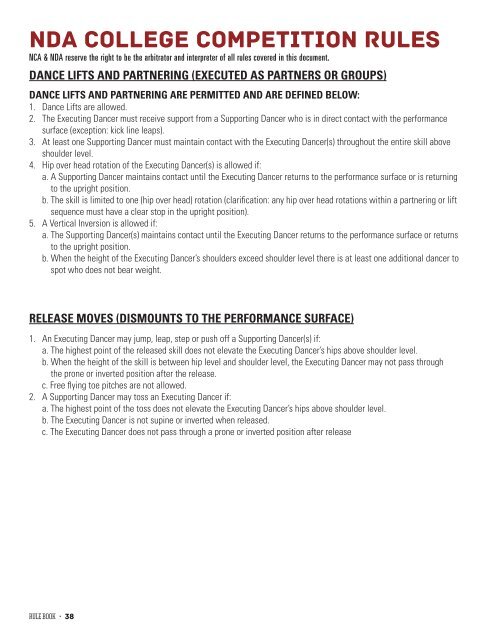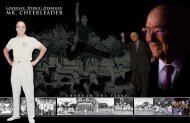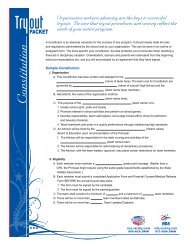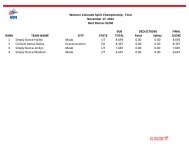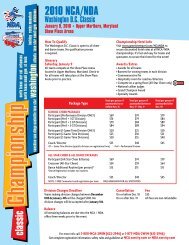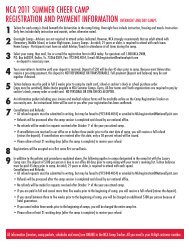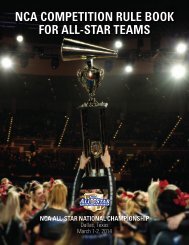nca & nda competition rule book for college teams - National ...
nca & nda competition rule book for college teams - National ...
nca & nda competition rule book for college teams - National ...
You also want an ePaper? Increase the reach of your titles
YUMPU automatically turns print PDFs into web optimized ePapers that Google loves.
NDA COLLEGE COMPETITION RULES<br />
NCA & NDA reserve the right to be the arbitrator and interpreter of all <strong>rule</strong>s covered in this document.<br />
DANCE LIFTS AND PARTNERING (EXECUTED AS PARTNERS OR GROUPS)<br />
DANCE LIFTS AND PARTNERING ARE PERMITTED AND ARE DEFINED BELOW:<br />
1. Dance Lifts are allowed.<br />
2. The Executing Dancer must receive support from a Supporting Dancer who is in direct contact with the per<strong>for</strong>mance<br />
surface (exception: kick line leaps).<br />
3. At least one Supporting Dancer must maintain contact with the Executing Dancer(s) throughout the entire skill above<br />
shoulder level.<br />
4. Hip over head rotation of the Executing Dancer(s) is allowed if:<br />
a. A Supporting Dancer maintains contact until the Executing Dancer returns to the per<strong>for</strong>mance surface or is returning<br />
to the upright position.<br />
b. The skill is limited to one (hip over head) rotation (clarification: any hip over head rotations within a partnering or lift<br />
sequence must have a clear stop in the upright position).<br />
5. A Vertical Inversion is allowed if:<br />
a. The Supporting Dancer(s) maintains contact until the Executing Dancer returns to the per<strong>for</strong>mance surface or returns<br />
to the upright position.<br />
b. When the height of the Executing Dancer’s shoulders exceed shoulder level there is at least one additional dancer to<br />
spot who does not bear weight.<br />
RELEASE MOVES (DISMOUNTS TO THE PERFORMANCE SURFACE)<br />
1. An Executing Dancer may jump, leap, step or push off a Supporting Dancer(s) if:<br />
a. The highest point of the released skill does not elevate the Executing Dancer’s hips above shoulder level.<br />
b. When the height of the skill is between hip level and shoulder level, the Executing Dancer may not pass through<br />
the prone or inverted position after the release.<br />
c. Free flying toe pitches are not allowed.<br />
2. A Supporting Dancer may toss an Executing Dancer if:<br />
a. The highest point of the toss does not elevate the Executing Dancer’s hips above shoulder level.<br />
b. The Executing Dancer is not supine or inverted when released.<br />
c. The Executing Dancer does not pass through a prone or inverted position after release<br />
RULE BOOK • 38


